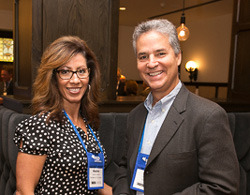Great venue, even better information and perfect audience
A couple of weeks ago, I had the opportunity to participate in the inaugural Foodservice Equipment & Design Global Thought Leadership Summit that took place at the Chicago Athletic Association hotel. Walking into the historic hotel my first reaction was that the FE&S/rd+d team does not know how to do anything second class. Just like FE&S’ Dealer of the Year and Industry Awards Gala that happens each year during the National Restaurant Association show, this conference did not disappoint: right venue, right information and right audience.
 I caught up with Nadine Rodriguez of Noodles & Company during one of the networking breaks at the Zoomba Group’s FED Summit.
I caught up with Nadine Rodriguez of Noodles & Company during one of the networking breaks at the Zoomba Group’s FED Summit.
So much was discussed and presented in the sessions that it would take me a full chapter to review all of the lessons I learned. Instead, this blog will recap a few of my thoughts and impressions. Let’s call these my take-aways.
Take-away 1: Grocers are eating restaurants for lunch.
It is one thing to read about how grocerants continue to infringe upon traditional restaurants in general terms, but a close examination of the data behind this shift in consumer behavior paints a much clearer picture of the impact these retailers continue to have on the foodservice industry.
While restaurants needed to raise menu prices to deal with the many business pressures they face, many of which come via policy changes such as increased healthcare premiums, mandatory minimum wage increases, etc., grocerants continue to take advantage of lower commodity pricing.
In fact, grocerants have been able to reduce what consumers pay since these foodservice operators don’t have the same labor cost pressures restaurants have.
 lFellow FCSI-The Americas members AJ Barker of Concept Kitchen + Bar (left) and I are all smiles during Zoomba Group’s FED Summit.The result is that they grocerants continue to consume a bigger share of foodservice sales.
lFellow FCSI-The Americas members AJ Barker of Concept Kitchen + Bar (left) and I are all smiles during Zoomba Group’s FED Summit.The result is that they grocerants continue to consume a bigger share of foodservice sales.
Take-away 2: Restaurant designers and operators must apply all available technology tools to enable efficiency during the design process and efficiency of execution at the store level.
This is necessary to combat today’s business challenges, take back any lost ground to competitors and deliver the best unit economics. This includes the application of the best and most innovative technologies available during the design process, such as three-dimensional design tools for both the form aspect of design and the functional aspect of design.
Proper implementation and use of store-level technology, such as self-ordering technologies (e.g. kiosks, smart phones, web, etc.) in the front of the house and production systems in the back of the house, are equally important.
Driving optimum unit economics means making effective and efficient use of the layout, the labor and ingredients to generate the highest possible return on investment.
Take-away 3: Don’t sleep on food safety.
I don’t need to elaborate too much on such a topic.
Even the most iconic and successful brands can be affected by food safety woes if they are not careful. One concept has spent most of this year dealing with a significant loss in sales, in profits and in shareholder value due to food-safety related issues.
More than the fiscal impact of food safety woes, it’s every operator’s obligation to run a food-safe business. I always say that food quality and food safety are non-negotiable.
Take-away 4: Culture is a must to succeed in the business world.
Start with understanding your organization’s current culture and how it may need to change to attract and maintain the talent necessary to give your company a competitive advantage.
Don’t kid yourself. And be ready to be surprised about what comes back when you ask employees for input, including how your own leadership style impacts the culture. If you want to succeed in the ultra-competitive business world we live in, you must have and live the right culture.
Make sure that in the area of culture, you walk the talk!
Take-away 5: People will follow real leaders.
Real leaders must find a way to connect to the team they are charged to lead, including on a personal level. To do this you must really care and understand what is important to the employees.
It is not about you, but rather about them.
If you understand this, your team will follow you, even if it is in an exercise to search for and destroy bombs in Afghanistan, which was the topic for one of the speakers. Success for this exercise was defined by the team’s ability to find improvised explosive devices, which could blow up in their faces or even under their vehicles, before they knew what happened.
There were many other topics discussed that provided me other take-aways, including how global changes will impact the foodservice industry on a local level, design for nontraditional restaurant spaces, virtual reality’s impact on the restaurant experience, achieving operational excellence and sharing knowledge across the industry, among many others.
I thanked the team at FE&S/rd+d for creating and facilitating a venue where we can get together with industry colleagues to learn, network, talk about business and just have fun in a great setting. Maureen referred to this session as an experiment. Well, from my perspective, and that of many others that I spoke with, it was a successful one.




